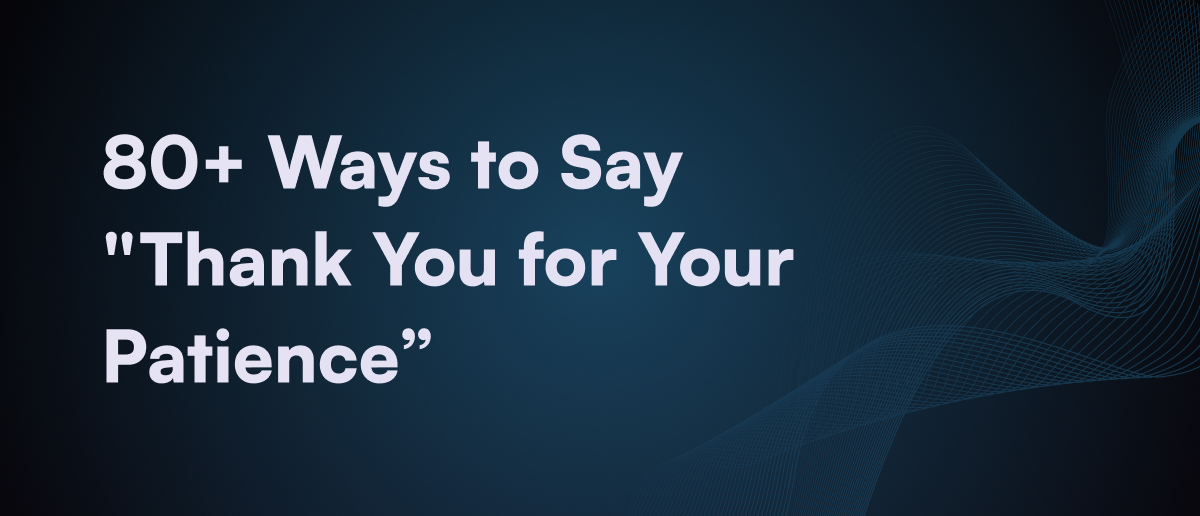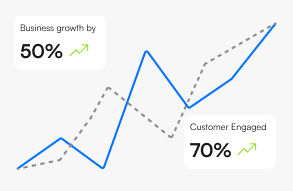Effective Thank You for Your Patience Messages: Easy Tips for SMB Leaders

Kasturi Goswami
October 30, 2024
17 min

Table of Contents
As a business leader, especially in an SMB, you know that customer communication is critical—yet keeping up with every inquiry can feel like juggling a dozen balls in the air. And when a customer feels left waiting, it’s not just patience that thins—it’s often their brand loyalty, too.
Nearly 40% of customers will likely switch brands if they receive poor customer service. That means how you handle every interaction, even the small “We’ll be with you soon” message, counts.
So, how do you convey the right message when your team or chatbot has to ask for patience? Let’s break down how simple yet thoughtful “Thank you for your patience” messages can help you connect with customers more meaningfully—even when delays happen.
Why does Saying “Thank You for Your Patience” Matter?
Here’s a reality check: nobody likes waiting. In fact, two-thirds of customers want an “immediate” response—like, within 10 minutes. But when that’s not always feasible, how you phrase your response can shift a customer’s experience from frustration to understanding.
A genuine, well-crafted message says, “We value your time, and we’re on it.” And that little bit of extra care can help your customers feel seen, appreciated, and, ultimately, more loyal.
For SMB leaders, it is important to remember that “Thank you for your patience” chatbot messages are an important strategic tool just as much as chatbot welcome messages, showing that you value your clients’ time and commitment. This phrase doesn’t just say, “We see you.” It says, “We care.”

So, What Does a Good “Thank You for Your Patience” Message Look Like?
Cain and Abel are two CEOs who aim to enhance customer experience using AI-driven
custom ai chatbots, yet their approaches reveal stark differences in strategy and impact.
Cain Corp.– led by efficiency-focused Cain—is all about speed. To handle high customer volumes, Cain uses a chatbot as the primary customer-facing contact. When delays arise, Cain Corp.’s chatbot sends a standard, no-frills message–short, direct, but generic–“Thanks for your patience. We’ll get back to you shortly.”
Abel Inc.– led by Abel, who sees customer experience automation as a way to foster genuine connections with customers. Abel values empathy and personalizes chatbot messages to build loyalty. His approach is warmer:“Hi [Customer’s Name], we know waiting isn’t easy. Thanks for your patience while we get this sorted for you.”
While both responses technically get the job done, which one makes the customer feel acknowledged? Hint: It’s the one that feels more personal.
- Also read: Understanding key drivers on customer service excellence in 2025
Integrating “Thank You for Your Patience” into your Customer Experience Strategy
Abel’s approach highlights an essential strategy many SMB business decision-makers overlook: empathy and consistency. By investing in empathy-driven automation, Abel Inc. doesn’t just manage inquiries; it builds trust and loyalty, transforming routine interactions into meaningful connections. Here’s how you can explore empathy-driven automation for your business:
1. Automate Responsively: Use chatbot technology to send tailored patience messages during peak times, ensuring that customers feel acknowledged when demand is high.
2. Train Your Team on Tone and Empathy: Build empathy into brand communication guidelines. Whether automated or human, responses should reflect an understanding of customer needs.
3. Monitor and Adjust: Continuously track response times and customer feedback, adjusting messaging to align with changing customer expectations and needs.
The Anatomy of a Perfect “Thank You for Your Patience” Chatbot Message
Let us break down what makes an ideal “Thank you for your patience” message, with examples showing progressive improvements at each level.
1. Clarity and transparency about delays
Honesty sets the tone. If there’s a delay, whether due to high demand, a technical issue, or staff shortages, let customers know. A simple line like, “We’re currently experiencing a higher volume of inquiries,” shows your commitment to transparency. Regular updates during a wait period help maintain positive perceptions of your brand.
Basic message:
“We’re experiencing a delay. Thank you for your patience.”
Improved message:
“We’re experiencing a higher-than-usual volume of requests. Thank you for your patience while we respond to each inquiry carefully.”
Enhanced message with transparency:
“Hello [Customer’s Name], due to a high volume of inquiries, response times are slightly longer. Rest assured, we’re working to address your request with the detail it deserves. Thank you for bearing with us!”
2. Personal touch
Automated responses are efficient, but personalization adds warmth. Taking a page from D2C companies, even small businesses can personalize responses by addressing customers by name and mentioning their specific inquiries.
Basic message:
“Thank you for your patience. We’ll be with you shortly.”
Improved message with personalization:
“Hi [Customer’s Name], thank you for waiting. We’ll have an answer for you soon.
Enhanced message with specificity:
“Hi [Customer’s Name], we’re reviewing your request for [specific issue]. Thanks for your patience; we’ll get back to you as soon as we can!”
These small touches not only personalize the response but also show customers they aren’t just another number in the queue.
3. Warmth with professionalism
No one likes a cold, corporate-sounding “We apologize for the inconvenience.” Instead, blend gratitude with assurance to keep the tone both friendly and respectful.
Basic message:
“Thank you for your patience. We apologize for the inconvenience.”
Improved message with warmth:
“Thank you for being so patient as we handle your request. We appreciate it!”
Enhanced message with warmth and professional assurance:
“Hello [Customer’s Name], we understand your time is valuable, and we’re grateful for your patience as we work to fulfill your request with care and attention.”
This approach conveys that you respect the customer’s time and that they’re not just another case in the queue. A warm yet professional tone assures them that they’re dealing with a brand that values both efficiency and personal connection.
4. Highlighting a positive outcome
Reframe the wait as a benefit by emphasizing the quality or special attention being added. Customers tend to feel more positive about delays when reassured that it is in their interest. It helps customers feel that their wait contributes to a better experience.
Basic message:
“Thank you for your patience; we’re taking extra time on your order.”
Improved message with outcome highlight:
“Thank you for waiting. We’re taking this extra time to ensure everything is done right.”
Enhanced message with positive framing:
“Thank you for your patience, [Customer’s Name]. This extra time allows us to fine-tune every detail, ensuring you receive the best possible result.”
5. Enthusiasm
Expressing enthusiasm can make customers feel that you’re as invested as they are in resolving their requests. It keeps the tone upbeat and reinforces your shared anticipation. Adding empathy to the message softens any frustration customers may feel and shows that their time and patience are valued.
Basic message:
“Thank you for waiting. We’ll be with you soon.”
Improved message with enthusiasm:
“Thank you for waiting. We can’t wait to deliver this to you!”
Enhanced Message with enthusiastic assurance:
“Hello [Customer’s Name]! Thanks for waiting – we’re just as excited as you are to get this to you and will have it ready shortly!”
6. Empathetic language
Empathy shows you understand and appreciate the customer’s patience, helping to make the wait more bearable. Words like “understanding” and “appreciation” reinforce that their patience matters.
Basic message:
“Thank you for waiting. We appreciate your patience.”
Improved message with empathy:
“Thank you for sticking with us. We know waiting isn’t easy.”
Enhanced message with empathy and personal connection:
“Hi [Customer’s Name], we understand that waiting can be tough, and we truly appreciate your patience while we give your request the attention it deserves.”
7. Commitment to quality
A focus on quality can transform a potential frustration point into reassurance. Customers are more willing to wait if they know that extra time means a better experience. By linking the wait to a commitment to quality, customers understand that their patience contributes to an experience worth waiting for.
Basic message:
“Thank you for your patience. We’re committed to getting this right.”
Improved message with quality emphasis:
“Thank you for your patience; we’re taking the necessary time to ensure everything is just right.”
Enhanced message with quality and assurance:
“Thank you for bearing with us, [Customer’s Name]. We’re committed to providing you the best possible experience, and this extra time helps us ensure everything is done with the utmost care and precision.”
8. Humor (when appropriate)
Humor can be a tricky tool in customer communication, but if your brand is known for a playful tone, a little light-heartedness can actually improve customer satisfaction.
Basic message:
“Thanks for your patience. We’re working on it.”
Improved message with light humor:
“We’re not ignoring you, promise! We’re on it and will be with you shortly.”
Enhanced message with personalized humor:
“Hi [Customer’s Name], thanks for sticking with us! Our team is giving your request the attention it deserves and should have you sorted in no time!”
Humor adds a human touch, making interactions feel genuine rather than robotic. However, keep in mind that humor isn’t universally applicable. If the delay is related to a sensitive issue, err on professionalism.
9. Acknowledging value
Expressing gratitude for the customer’s patience can strengthen their connection to your brand. When customers feel valued, they’re more likely to feel positively toward your brand, even in the face of a delay. It builds loyalty and reinforces that each customer is valued as an individual, not just a transaction.
Basic message:
“Thank you for your patience.”
Improved message with value acknowledgment:
“We appreciate your patience and value having customers like you.”
Enhanced message with sincere appreciation:
“Thank you, [Customer’s Name], for your patience and understanding. We’re grateful for customers like you who make our work so meaningful.”
10. Ending on a positive note
Concluding with a positive tone helps customers leave the interaction with a good impression. This final line can create a sense of closure and leave the door open for future updates.
Basic message:
“Thanks again for waiting.”
Improved message with positivity:
“Thanks once again for your patience. We’ll be in touch soon!”
Enhanced message with friendly closure:
“Thank you again for your patience, [Customer’s Name]! We’ll keep you updated and can’t wait to deliver this to you soon.”
This warm closing leaves a positive mark, emphasizing that the brand is communicative, appreciative, and looking forward to delivering.

Crafting a “Thank You for Your Patience” Chatbot Message for 30 Different Customer Scenarios
1. High volume of customer requests
Message: “Hi [Customer’s Name], we’re experiencing a high volume of requests and appreciate your patience as we respond thoroughly to each inquiry.”
Tip: Acknowledge each customer’s importance during peak times.
2. Service delays due to technical issues
Message: “Hello [Customer’s Name], we’re facing a technical hiccup. Thank you for sticking with us as we work on a quick resolution!”
Tip: Emphasize your team’s effort to address the issue.
3. Custom order processing
Message: “Hi [Customer’s Name], we’re putting the finishing touches on your custom order. Thank you for your patience—it’ll be worth it!”
Tip: Show that the delay enhances their unique order.
4. Product back order
Message: “Hello [Customer’s Name], due to high demand, your item is on back order. Thanks for your patience as we work to restock and ship soon!”
Tip: Share the reason for the delay and your restocking efforts.
5. Short-staffed customer support
Message: “Dear [Customer’s Name], we’re operating with a smaller team and appreciate your patience as we assist each valued customer.”
Tip: Reassure customers of personalized service despite delays.
6. Ongoing software update
Message: “Hi [Customer’s Name], a software update may affect access temporarily. Thanks for your patience while we improve your experience!”
Tip: Frame the wait as beneficial for improved service.
7. Shipping delays during peak season
Message: “Hi [Customer’s Name], due to the holiday rush, shipping is delayed. Thank you for your patience—we’re working to get your order out ASAP!”
Tip: Acknowledge the season to explain potential delays.
8. Extended processing time for personalized services
Message: “Hello [Customer’s Name], we’re carefully customizing this just for you. Thanks for your patience as we make it perfect!”
Tip: Highlight the attention to detail in creating their custom experience.
9. Website downtime
Message: “Hi [Customer’s Name], our website is down for maintenance. Thanks for waiting while we work to restore access soon!”
Tip: Emphasize that maintenance will bring an improved experience.
10. Processing refunds
Message: “Hello [Customer’s Name], thanks for your patience as we process your refund. It should appear in your account within [time frame].”
Tip: Set a clear expectation for the refund timeline.
11. Service outage impacting functionality
Message: “Hi [Customer’s Name], due to an unexpected outage, some services may be down. Thank you for bearing with us as we resolve this.”
Tip: Be transparent about the outage and reassure them that it’s temporary.
12. Supply chain delays affecting product availability
Message: “Hello [Customer’s Name], supply chain delays are affecting availability. Thanks for your patience as we closely track your order!”
Tip: Explain external factors affecting product availability.
13. Unplanned maintenance
Message: “Dear [Customer’s Name], we’re undergoing maintenance to improve services. Thanks for your understanding—we’ll be back shortly!”
Tip: Focus on the positive outcome of the maintenance.
14. Quality control checks causing a delay
Message: “Hello [Customer’s Name], additional quality checks are causing a delay. Thanks for your patience as we ensure your order meets our standards!”
Tip: Show that the delay is for quality assurance.
15. Delayed product launch
Message: “Hi [Customer’s Name], we’re perfecting our new product, so the launch is delayed. Thanks for your patience—we’re excited to share it soon!”
Tip: Build anticipation for the delayed product.
16. Product update waiting period
Message: “Thank you for your patience as we work on [specific update]. We’ll update you soon!”
Tip: Mention the product update to reassure the customer.
17. High demand for customer support
Message: “We’re assisting many valued customers right now, and we appreciate your patience as we respond to each one.”
Tip: Show that each customer is a priority, even during busy periods.
18. Delay from technical issues
Message: “Due to a temporary issue, service is delayed. Thank you for your patience while we resolve this!”
Tip: “Temporary” reassures customers the issue is being handled.
19. Project delay for quality improvement
Message: “Thank you for giving us time to make this project the best it can be. We’re excited to deliver soon!”
Tip: Emphasize that the delay allows for a higher-quality result.
20. Out-of-Stock item delay
Message: “We’re working to restock your item. Thank you for your patience—it’ll be worth the wait!”
Tip: Show enthusiasm for fulfilling the order soon.
21. Busy season delay
Message: “It’s a busy season, and we’re working hard! Thanks for hanging in there.”
Tip: Make it relatable by acknowledging the busy season.
22. Waiting on verification
Message: “Thanks for bearing with us as we complete checks. Your patience helps us maintain high standards!”
Tip: Acknowledge the importance of verification for quality.
23. Complex issue resolution
Message: “We’re diving deep into your issue, and we appreciate your patience as we find a lasting solution.”
Tip: Show commitment to addressing the issue thoroughly.
24. Waiting for a refund
Message: “We know waiting for a refund can be tough, so thank you for your patience. It’s in progress!”
Tip: Acknowledge the sensitivity of refunds and show empathy.
25. Custom order preparation
Message: “Creating something just for you takes time, and we’re grateful for your patience as we make this order perfect.”
Tip: Highlight the value of the custom service.
26. Unplanned service maintenance
Message: “To improve your experience, we’re performing maintenance. Thanks for your patience while we complete this work!”
Tip: Focus on the benefit of the maintenance.
27. Delayed shipping
Message: “Your order is on its way! Thanks for sticking with us through this delay. We’ll update you soon.”
Tip: Use positive language like “on its way” to reassure them.
28. Delays due to global events
Message: “Due to circumstances beyond our control, we’re experiencing delays. Thanks for your understanding during this time.”
Tip: Emphasize external factors and show appreciation for understanding.
29. Research & development delays
Message: “Good things take time! We’re perfecting [product/feature]. Thank you for your patience as we bring it to life.”
Tip: Spin the wait as part of creating something worthwhile.
30. Feature request review
Message: “Your feedback is important! Thanks for your patience as we review your request with our team.”
Tip: Acknowledge the customer’s contribution and show appreciation.
40 Unique and Creative ways to Express “Thank You for Your Patience” in General
Casual and friendly approaches
1. “Your time is precious, and we’re so grateful you’re hanging in there with us.”
2. “Thanks for giving us the room to do this right. We’re nearly there!”
3. “You’ve been amazing for sticking with us—your support doesn’t go unnoticed.”
4. “We know it’s been a wait. Thanks for sticking by our side as we sort this out!”
5. “You’re a star for your patience! We’re almost ready for you.”
6. “Thanks for standing by as we bring everything together for you.”
7. “You’ve been a trooper, and we’re so thankful for that!”
8. “Your patience deserves a standing ovation—thank you!”
9. “We’re lucky to have someone like you by our side. Thanks for your support!”
10.“You’re the real MVP for giving us the time we need. Thank you!”
Professional and appreciative
11. “Your patience means a lot to us. We’re grateful you’re giving us this opportunity to get it right.”
12. “Thank you for your understanding as we work to deliver the quality you expect.”
13. “You’ve been incredibly gracious, and we deeply appreciate it.”
14. “We appreciate your patience and trust as we handle this for you.”
15. “Your patience shows the true spirit of partnership—thank you for being part of our journey.”
16. “Thank you for allowing us the time to ensure everything’s just right for you.”
17. “Your support throughout this process has made all the difference. Thank you!”
18. “We’re grateful to have understanding clients like you—it makes our work so worthwhile.”
19. “Your patience speaks volumes about your trust in us. Thank you for believing in our team.”
20. “Thank you for giving us the space to make this perfect for you.”
- Also read: A guide on perfecting customer welcome messages
Empathetic and warm
21. “We know waiting isn’t easy, and we’re so grateful for your patience.”
22. “Your support has been invaluable—thank you for allowing us this time to serve you best.”
23. “Your patience helps us make things better—thank you for trusting our process.”
24. “We’re humbled by your understanding and truly thankful for your support.”
25. “Thanks for staying with us as we work to create something special just for you.”
26. “We couldn’t ask for a better customer—thanks for hanging in there with us.”
27. “You’re helping us reach new heights—thank you for giving us the runway to do our best work.”
28. “We’re honored to work with someone as understanding as you—thank you.”
29. “Thanks for believing in us and giving us the time to make this right.”
30. “We value you so much for giving us the chance to make this a success.”
Playful and unique expressions
31. “You’re a rockstar for waiting with us! We’re almost there!”
32. “Thanks for being our steady hand through this journey—we won’t forget it.”
33. “We appreciate you holding tight while we bring everything together!”
34. “Thanks for being our co-pilot as we navigate this! We’ll have answers soon.”
35. “You’ve been incredibly patient, and we promise it’s worth the wait!”
36. “Your loyalty shines bright—thanks for being here with us!”
37. “Thanks for being an anchor in this process. We’ll have smooth sailing soon!”
38. “You’re the kind of customer we dream of—thanks for your incredible patience!”
39. “Thank you for giving us the time to make magic happen. We’re excited to share it with you!”
40. “Your patience has made all the difference—we’re grateful to have you on this journey.”
- Also read: Top customer service quotes in 2025 to inspire quality service from your SMB team
Small Words, Big Impact
In the end, a simple gratitude message holds more weight than one might think. It’s not about placating customers; it’s about showing them that they matter.
For SMBs, every interaction counts, and these moments of acknowledgment can drive loyalty and trust, which are priceless assets in today’s competitive market. One of the most effective ways of building the right customer connections is through automating these gratitude messages.
AI-driven chatbots like the ones powered by Thinkstack can be configured to detect inquiry surges and automatically send a “Thank you for your patience” message tailored to the client’s need. For instance, your chatbot might say:
“Hi there! We’re currently handling more requests than usual. Thank you for your patience; our team will be with you as soon as possible.”
As you consider refining your customer communications, remember the power of a well-placed thank you automated message. It’s more than just a phrase—it’s a statement of your brand’s commitment to customer satisfaction.

Grow Your Business with AI Chatbots
- Automate tasks
- Engage customers 24/7
- Boost conversions